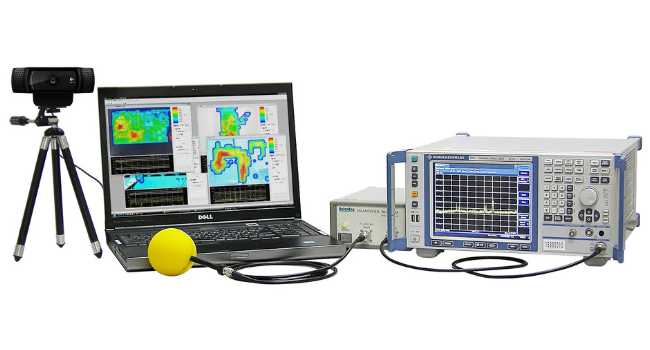The Rigol DSA815 Spectrum Analyser has a built in Limit Line test that can be a convenient way to measure and compare spectral power against specific masks used for various signal types.
One common test is NRSC Amplitude Modulation (AM) test. In this example, we are going to use the Pass/Fail mask to evaluate an AM Channel vs. limits set up by the National Radio Systems Committee (NRSC).
Here is an excerpt from the FCC rule 73.44
“The emissions of stations in the AM service shall be attenuated in accordance with the requirements specified in paragraph (b) of this section. Emissions shall be measured using properly operated and suitable swept-frequency RF spectrum analyser using a peak hold duration of 10 minutes, no video filtering, and a 300 Hz resolution bandwidth, except that a wider resolution bandwidth may be employed above 11.5 kHz to detect transient emissions.
Alternatively, other specialized receivers or monitors with appropriate characteristics may be used to determine compliance with the provisions of this section, provided that any disputes over measurement accuracy are resolved in favour of measurements obtained by using a calibrated spectrum analyser adjusted as set forth above.”
This provides the instrument settings we will use throughout this example.
1. Set Center Frequency to match the channel you are monitoring. In this example, we are testing 1100kHz
• Press Freq > Center and adjust using the keypad or scroll wheel
2. Set Span. In this case, we are testing AM NRSC which currently specifies 100kHz.
• Press Span > Span and adjust using the keypad or scroll wheel
3. Set RBW and VBW. This example requires 300Hz RBW and no video filter.
We cannot disable VBW, but setting it larger than RBW effectively disables it.
• Press BW/Det > RBW and adjust using the keypad or scroll wheel to 300Hz
• While in the BW/Det menu, adjust the VBW to 3MHz.
4. Configure the analyser for a timed total. This test is specified for a total data collection time of 10 minutes. The easiest method to enable a timed test is to use the sweep and trigger controls of the instrument.
• Press Sweep > Mode > Single
• Set Sweep Number > 600 ( at approximately 1.111s/sweep, this is a bit over 10 minutes)
5. Set trace type to Max Hold
• Press Trace > Trace Type > Max Hold
6. Build Pass/Fail Limit line
• Build This can be performed manually or programmatically. See the Application Note titled “How do I create limit lines manually on the DSA815 series? or the Pass/Fail Limit builder software available for download on the DSA815 Product page located here www.rigolna.com.
7. Enable the Mask by pressing Trace/P/F > Pass/Fail > Switch On
• Option: Pass/Fail Limit line press Trace/P/F > On > Setup
• Option: Fail Stop Off/On to control the End Test On Failure Mode
• Option: Beeper on Fail Off/On (P/F Menu 2/2)
8. When ready to start the test, press Sweep/Trig > Single
• You can check the sweep count on the right hand side of the display
9. After the test is complete, you can save a bitmap to an external USB memory.
• Insert USB stick into front USB port and wait for instrument to recognize the USB device.
• If the device is not recognized, try another memory stick. USB drives with minimal files and folders will have a greater degree of success. Erase unneeded files and retry.
• Press the printer icon to save a BMP.
NOTE: You can also save CSV data by pressing the Storage key.
10. Clear traces and retest
• Turn off mask – Press Trace/P/F > Off
• Press Trace > Trace 1 > Type > Blank
• Press Trace > Trace 1> Type > Max Hold
• Press Trace/P/F > On
• Press Start to begin test

































































































 FREE SHIPPING £75+
FREE SHIPPING £75+
 CELEBRATING 50+ YEARS
CELEBRATING 50+ YEARS
 PRICE MATCH GUARANTEE
PRICE MATCH GUARANTEE




